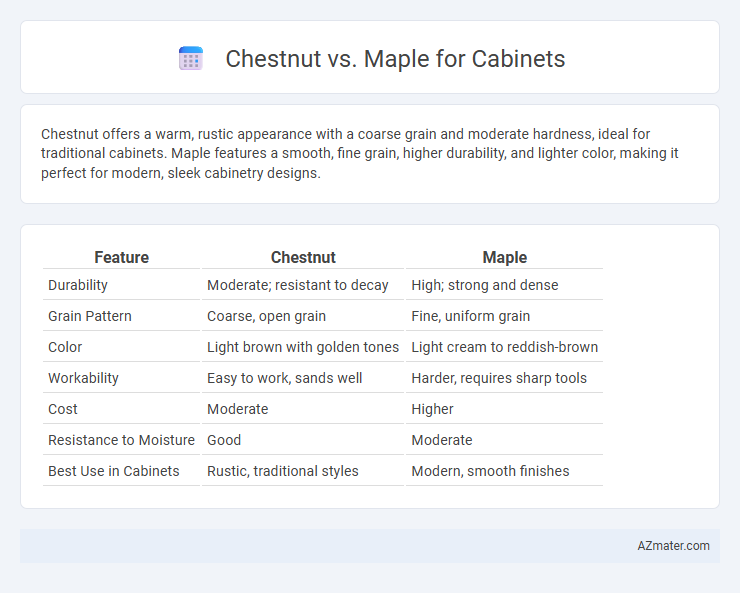Chestnut offers a warm, rustic appearance with a coarse grain and moderate hardness, ideal for traditional cabinets. Maple features a smooth, fine grain, higher durability, and lighter color, making it perfect for modern, sleek cabinetry designs.
Table of Comparison
| Feature | Chestnut | Maple |
|---|---|---|
| Durability | Moderate; resistant to decay | High; strong and dense |
| Grain Pattern | Coarse, open grain | Fine, uniform grain |
| Color | Light brown with golden tones | Light cream to reddish-brown |
| Workability | Easy to work, sands well | Harder, requires sharp tools |
| Cost | Moderate | Higher |
| Resistance to Moisture | Good | Moderate |
| Best Use in Cabinets | Rustic, traditional styles | Modern, smooth finishes |
Introduction to Chestnut and Maple Wood
Chestnut wood is prized for its lightweight strength, straight grain, and warm, golden-brown hue, making it a popular choice for durable and rustic cabinetry. Maple wood, known for its hardness, fine texture, and pale creamy color, offers excellent resistance to wear and a smooth finish ideal for contemporary and traditional cabinet designs. Both species provide unique aesthetic and structural qualities, but chestnut excels in historical charm while maple stands out for modern durability and versatility.
Appearance and Grain Patterns
Chestnut cabinets feature a warm, reddish-brown hue with prominent, straight grain patterns that create a rustic and traditional ambiance, while maple cabinets offer a lighter, creamy color with fine, uniform grain that delivers a smooth and modern appearance. The dense texture of chestnut wood typically exhibits more pronounced knots and swirls, enhancing its natural character, whereas maple's consistent grain provides a clean, sleek look favored in contemporary cabinetry. Choosing between chestnut and maple depends on the desired aesthetic, with chestnut highlighting bold, earthy tones and maple emphasizing subtle elegance and brightness in kitchen design.
Durability and Hardness Comparison
Chestnut wood exhibits moderate hardness and durability, making it suitable for cabinets but prone to dents and scratches under heavy use. Maple ranks higher in both hardness and durability, characterized by a Janka hardness rating of approximately 1450, which provides strong resistance to wear and impact in cabinet applications. Choosing maple enhances cabinet longevity and surface integrity, especially in high-traffic environments.
Color Variations Over Time
Chestnut wood exhibits warm, reddish-brown hues that deepen and develop a rich patina over time, enhancing cabinet character. Maple offers a lighter, cream to pale yellow tone that may darken slightly with age while maintaining a smooth, consistent appearance. Both woods age beautifully, but chestnut's color variation is more pronounced, providing a rustic, antique look compared to maple's subtle, elegant evolution.
Workability and Ease of Crafting
Chestnut offers excellent workability due to its straight grain and medium texture, making it easy to plane, sand, and carve for cabinet crafting. Maple is harder and denser, which can challenge beginners but provides superior durability and a smooth finish when properly crafted. Both woods respond well to staining, but chestnut's softness allows quicker shaping, while maple requires sharper tools for precise cuts and detailed joinery.
Cost and Availability
Chestnut cabinets generally cost less than maple due to the wood's relative abundance and lower demand, making it a budget-friendly option for cabinetry. Maple is more widely available and prized for its hardness and fine grain, which can increase costs but also ensures long-term durability and a smoother finish. Availability of chestnut is limited compared to maple, which is extensively harvested and sold in various grades, impacting project timelines and budget considerations.
Environmental Sustainability
Chestnut cabinets offer greater environmental sustainability due to faster growth rates and more abundant availability compared to maple, reducing deforestation impact. Maple, though durable and aesthetically pleasing, typically requires longer maturation periods, leading to slower replenishment and higher ecological footprints. Choosing chestnut supports responsible forestry practices and promotes biodiversity by minimizing habitat disruption.
Maintenance and Long-Term Care
Chestnut cabinets require regular oiling and sealing to maintain their natural appearance and prevent drying or cracking over time. Maple cabinets, known for their dense and smooth grain, offer greater resistance to dents and scratches, making them easier to clean and maintain with simple wiping and occasional refinishing. Over the long term, maple's durability translates to lower maintenance costs compared to chestnut, which demands more frequent upkeep to preserve its aesthetic and structural integrity.
Best Design Styles for Chestnut and Maple Cabinets
Chestnut cabinets excel in rustic, traditional, and farmhouse design styles due to their rich, warm tones and prominent grain patterns that add character and natural beauty. Maple cabinets, with their smooth, pale, and uniform appearance, are ideal for contemporary, modern, and minimalist kitchens, providing a clean and versatile backdrop for various color palettes. Both woods offer durability, but maple's fine texture allows for a sleek, polished finish, while chestnut's distinctive grain enhances spaces seeking warmth and authenticity.
Choosing the Right Wood for Your Cabinets
Chestnut offers a unique, rich glow with a durable hardwood structure, making it an excellent choice for cabinets requiring both strength and aesthetic warmth. Maple provides a smooth, consistent grain and light tone that easily accepts stains and finishes, ideal for versatile cabinet styles and color schemes. Selecting between chestnut and maple depends on desired durability, grain pattern, and color preference for a tailored kitchen or storage solution.

Infographic: Chestnut vs Maple for Cabinet
 azmater.com
azmater.com